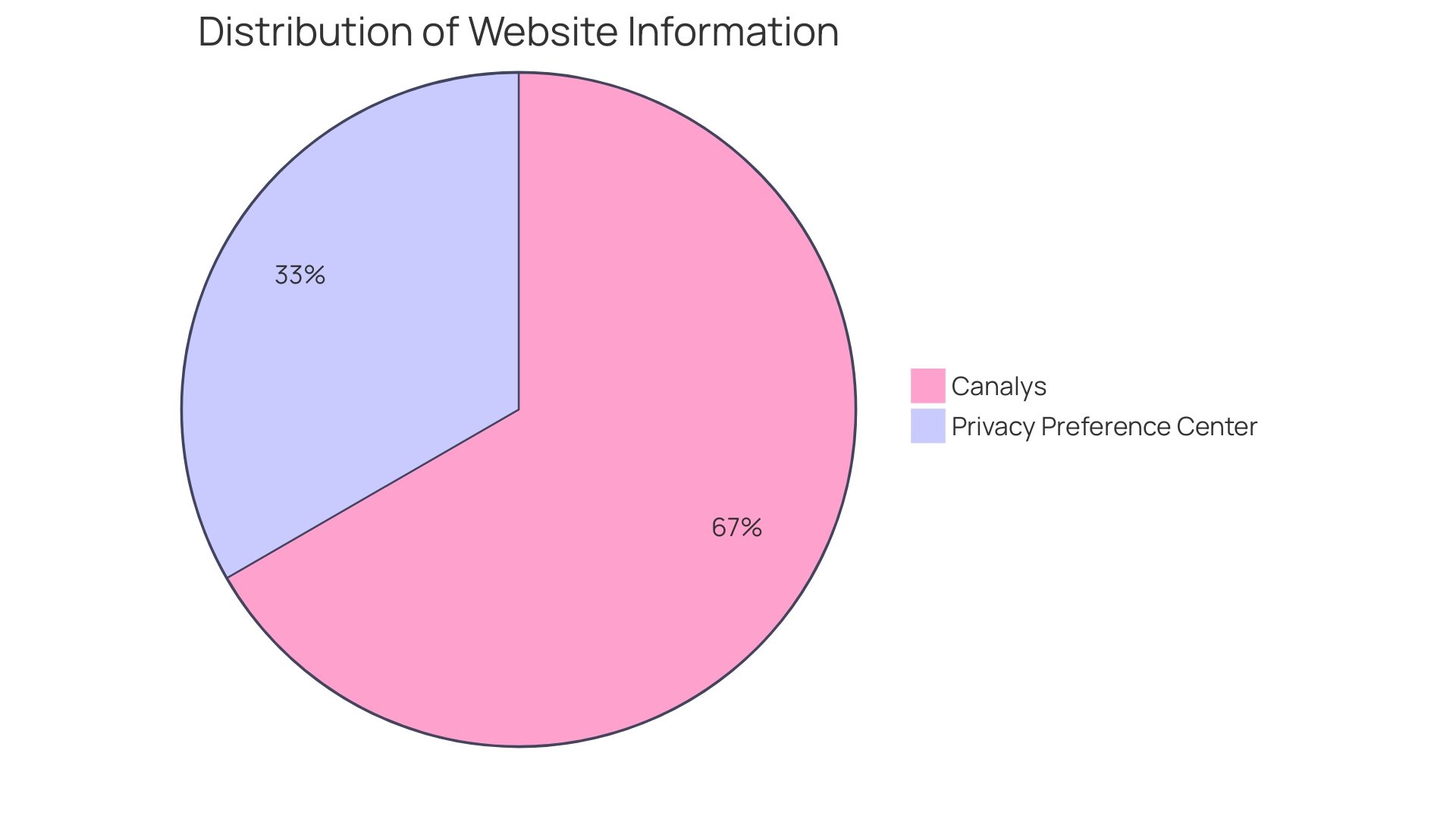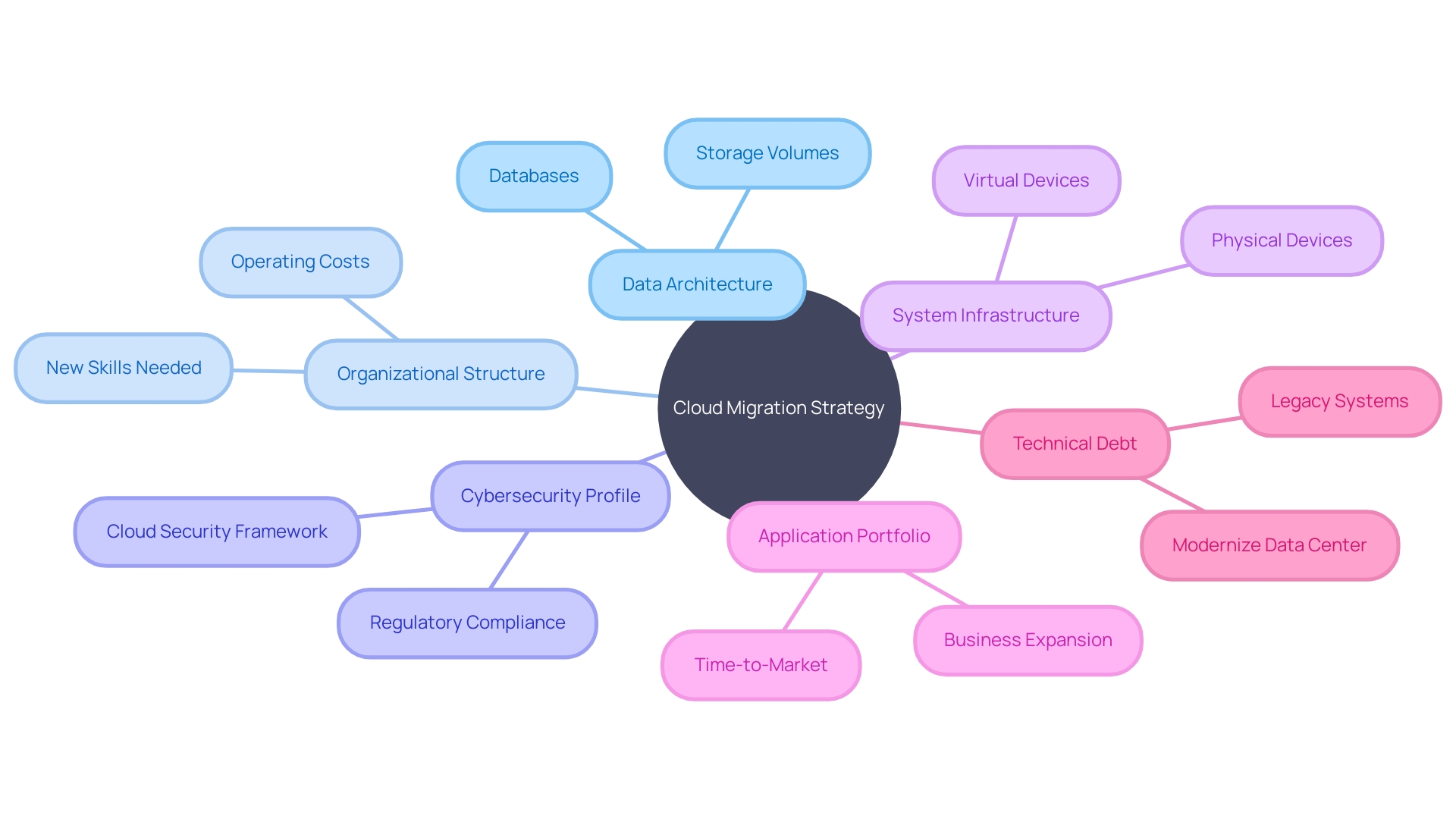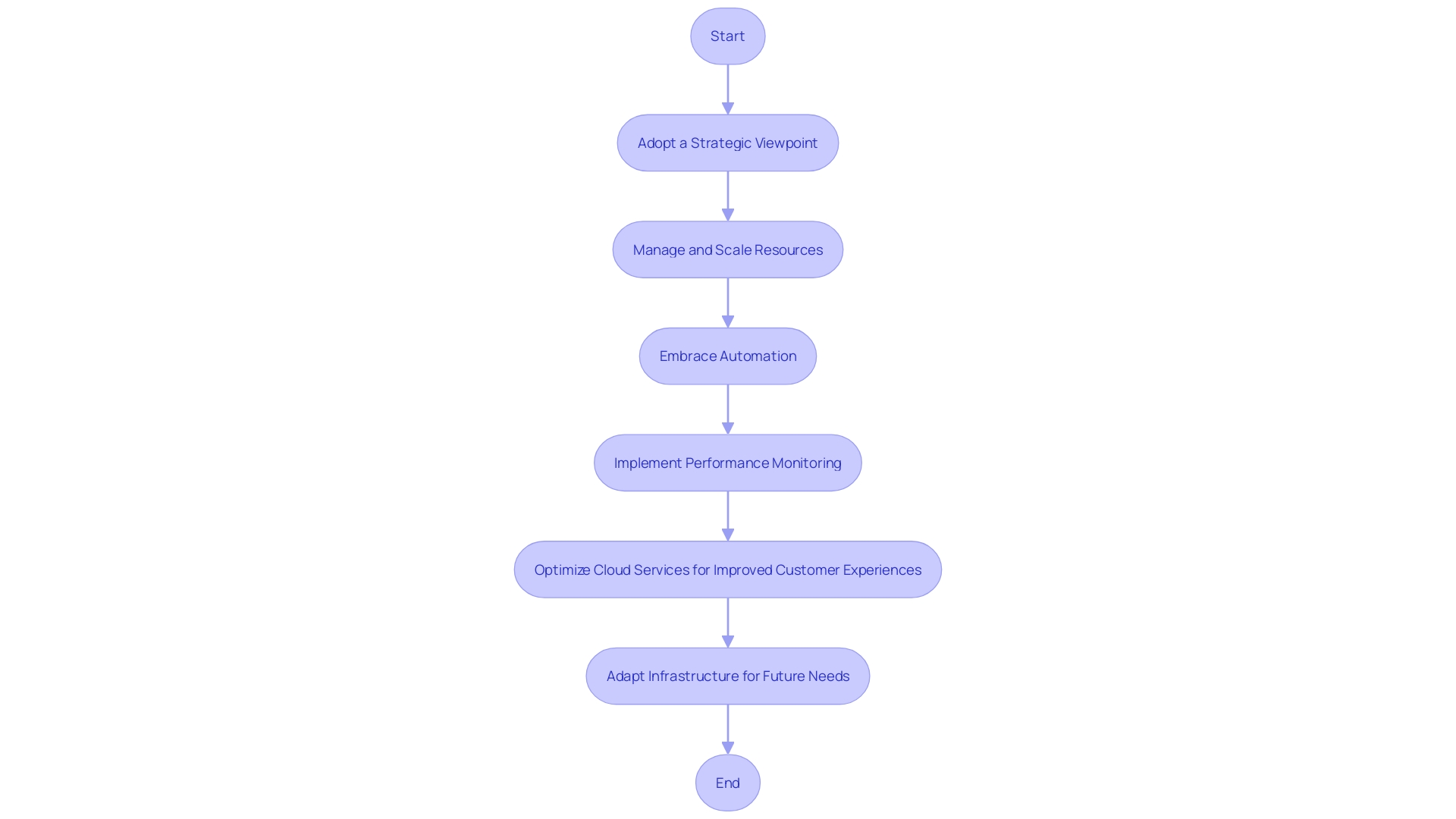Introduction
Cloud assessment is a crucial process for businesses preparing for cloud migration or looking to improve their existing cloud setups. This multifaceted assessment involves examining IT infrastructure, applications, and workloads to determine their readiness for the cloud. It also identifies security vulnerabilities and evaluates the compatibility of existing applications with cloud services.
By utilizing assessment tools and reviewing detailed reports, businesses gain valuable insights into their IT environment's condition, enabling them to make informed decisions for cloud modernization. The strategic importance of cloud assessment is exemplified by real-world case studies and industry insights, emphasizing the need for a well-executed assessment as a strategic business initiative. As the cloud computing market continues to grow, a comprehensive cloud assessment becomes imperative for maximizing ROI, driving business transformation, and harnessing advanced technologies.
Understanding Cloud Assessment: Key Components
A comprehensive evaluation of the cloud is a multifaceted process that is crucial for businesses preparing for migration or seeking to enhance their current setups. It involves a comprehensive evaluation of IT infrastructure, applications, and workloads to assess their preparedness for a cloud-based setting. The evaluation also identifies security vulnerabilities, ensuring data protection and privacy are not compromised during the transition. Additionally, it assesses the compatibility of current applications with online services, which is crucial for sustaining performance after migration.
One of the main benefits of evaluating the cloud is the clarity it brings to the current state of a company's IT landscape. By utilizing tools such as scripts, questionnaires, and diagnostic instruments, businesses can collect and analyze data that offer insights into performance, security, and compliance. The process does not end at data collection; it extends to reviewing detailed reports that outline the IT environment's condition, which aids in making informed decisions for modernization.
The strategic significance of evaluating cloud services can be illustrated by the cooperation between AWS and New Hope Dairy to construct an intelligent farm utilizing cloud-based technology. This case study highlights how a careful evaluation of needs and the deployment of a minimum viable product can rapidly produce value, with iterative improvements over time. Such an approach underscores the importance of not only the technological aspects but also the alignment of strategy with business objectives.
Insights from the industry further emphasize the importance of evaluating cloud solutions. The computing market, valued at $723.4 billion in 2023, is expected to grow significantly, driven by factors such as IoT integration, AI demand, microservices architecture adoption, and the DevOps model. These trends indicate that a well-executed evaluation of cloud computing is not only a technical endeavor but also a strategic business initiative that can result in IT efficiency, business advancement, and the utilization of cutting-edge technologies like generative AI.
In essence, a cloud evaluation is a crucial step that provides a basis for making strategic decisions regarding investments in cloud computing, which should be weighed against their potential advantages to maximize return on investment and propel business transformation.

Infrastructure Assessment
Evaluating the current infrastructure is a pivotal element in assessing cloud computing. This involves a thorough examination of servers, networks, and storage to pinpoint opportunities for enhancement and optimization. A durable system not only withstands incidents but also recovers swiftly, ensuring minimal impact on customers. In this way, a thorough evaluation concentrates on the general system resilience in the sky - getting ready for potential incidents, lessening their impact, and allowing efficient recovery without compromising long-term results.
Leveraging tools and methodologies, such as those provided by Microsoft, is essential for data collection and analysis, enabling a nuanced view of performance, security, and compliance aspects. The insights gleaned from these assessments can guide improvements in IT infrastructure that align with evolving data center trends, such as scalability and energy efficiency.
Recent reports highlight the significance of computing in the sky, with the market size revenue valued at $723.4 billion in 2023 and a projected CAGR of over 18%. Organizations are motivated to optimize their infrastructure to capitalize on this growth, driven by the integration of IoT, AI advancements, microservices architecture adoption, and DevOps model utilization.
Incorporating lessons from case studies, such as IFCO's collaboration with Rackspace Technology, can also provide insights to the evaluation process. IFCO's experience highlights the advantages of partnering with seasoned experts to navigate the intricacies of cloud migration.
Ultimately, a meticulous evaluation of the infrastructure lays the groundwork for a resilient, adaptable, and efficient environment, contributing to the sustained success of the company in a competitive landscape.

Application Portfolio Assessment
Thorough cloud assessment is a crucial step for entities aiming to migrate their applications with the goals of enhancing IT productivity, spurring business innovation, and leveraging advanced technologies. The process starts by dissecting the data architecture of an entity—scrutinizing where data resides, the security measures in place, its movement, analysis, and underpinning technologies. This examination frequently uncovers a variety of technologies in use, even within entities that uphold strict IT governance standards.
A thorough assessment extends to understanding the organizational structure, which typically bifurcates into teams handling front-of-house operations, integral to driving business and revenue, and teams dedicated to back-of-house analytical systems. It is crucial to recognize that similar functions may be performed across different sectors of the organization, employing varied technologies.
The intricate nature of operational and technological landscapes can significantly influence the outcome of migration to a different computing environment. Factors such as cybersecurity profile, system infrastructure, the application portfolio, and data architecture must be scrutinized, alongside the technical debt, to ascertain their impact on the migration process. The Azure team at Microsoft, headed by Principal Data Scientist Manager Rohit Pandey and Data Scientist Akshay Sathiya, highlights the intricacy of challenges in improving performance in cloud-based settings. They advocate for the use of tailored optimization algorithms to navigate the constraints of time and computational resources, aiming for a near-optimal solution.
To achieve this objective, a migration strategy to the cloud is not just a transfer of assets but a blueprint that requires a detailed analysis to ensure a secure and successful transition. This involves prioritizing applications based on business imperatives, such as processing times and sensitivity, and employing a dynamic planning approach that merges automation with manual processes. Such a comprehensive approach is crucial to optimize the ROI from the adoption of cloud services, as emphasized by recent research on the diverse benefits of cloud deployments in terms of IT effectiveness, business creativity, and the emergence of generative AI.

Data Assessment
The significance of a meticulous assessment of the cloud cannot be overstated, as it underpins the effectiveness of data migration and ensures alignment with an entity's strategic objectives. When it comes to migration, companies like Lincoln Financial Group highlight the importance of adopting a multiprovider strategy and the integration of partners from the onset, fostering a collaborative approach that transcends traditional organizational borders. Security considerations are paramount, requiring a deep understanding of legacy system intricacies and ensuring compliance with contemporary standards.
The strategic prioritization of applications, as demonstrated by Lincoln Financial, is informed by business imperatives, factoring in elements such as processing times and the sensitivity of applications. This underscores the criticality of a dynamic planning process that adeptly marries automation with manual interventions. Furthermore, the development of a comprehensive manual, similar to the availability and shared knowledge repository of Wikipedia, can democratize data gathering and facilitate the unrestricted movement of information within a company, thereby simplifying the transition to the online storage.
In line with McKinsey's discussion with Lincoln Financial's executives, the process of migrating to the cloud is tied to reducing operational costs, mitigating expenses associated with specialized software, and transitioning to a more adaptable technological environment. Furthermore, Microsoft's distinction between 'assessment' and 'review' highlights the utility of assessment tools that enable data analysis and collection, ultimately empowering organizations with a granular comprehension of their IT landscape, including security vulnerabilities, application compatibility, and performance optimization.
The complex process of migration testing, as explained by HeadSpin, is similar to ensuring a harmonious fit of one's belongings in a new house. It is a thorough evaluation to guarantee the migration's success without disrupting business operations. According to David S. Linthicum, the trajectory of conferences related to cloud computing moving towards generative AI is evidence of the evolving landscape of cloud computing, which can further amplify the potential of cloud adoption across various industries.
To sum up, a company's journey to readiness for cloud computing requires a comprehensive approach to data evaluation, encompassing categorization, security requirements, and strategies for migration. This approach should be reinforced by empirical insights and an adaptable mindset, allowing entities to navigate the complexities of migrating to the cloud with confidence and strategic foresight.
The Cloud Assessment Process: A Roadmap to Success
Navigating the cloud evaluation process is crucial for organizations aiming to modernize their IT infrastructure effectively. Microsoft makes a differentiation between 'evaluation' and 'review', stressing that a review includes multiple evaluations. The evaluation process involves utilizing specialized tools to gather and analyze data, which may incorporate scripts, questionnaires, and diagnostic tools specific to the evaluation's focus. By implementing these tools on current infrastructure, companies can gain valuable insights into performance, security, and compliance.
The benefits of conducting a comprehensive assessment are manifold. It offers clarity on the current state of an organization's IT environment, including infrastructure, applications, and workloads. It is instrumental in identifying security vulnerabilities, enabling companies to take proactive steps towards enhancing data protection and privacy. Furthermore, it evaluates the compatibility of existing applications with cloud environments, guaranteeing seamless transitions and maintaining performance levels during migration. Additionally, it provides the opportunity to optimize the performance of servers, workloads, and other components, leading to improved efficiency and resource utilization.
Real-world examples, such as the partnership between IFCO and Rackspace Technology, illustrate the significance of experience and expertise in assessments related to computing in the cloud. Rackspace's emphasis on customer requirements and ability to provide valuable insights and alternative approaches highlights the importance of comprehensive planning and review in the modernization process.
Present patterns indicate a notable shift towards multi-cloud environments, with 62% of firms already utilizing them and 18% in the midst of transitioning. The multi-cloud strategy is recognized for its flexibility, agility, and cost-effectiveness, which are key to reducing organizational risk and achieving long-term resilience. It is clear that system resilience is not only about withstanding incidents but also about the capacity to recover swiftly and evolve to mitigate future risks.
Considering these viewpoints, organizations are encouraged not to solely concentrate on expense when adopting cloud-based services. Instead, they should consider core drivers such as agility, flexibility, and innovation. Calculating the total cost of ownership and return on investment over a more extended period, such as five years, is recommended since benefits and savings often materialize over the long term. As the landscape of cloud computing continues to evolve, regulatory bodies like Ofcom are taking notice of potential anti-competitive practices, signaling that strategies for cloud services must be developed with an understanding of the broader industry context.
Cloud Optimization: Importance and Benefits
Enhancing services in the sky is not just about utilizing new technologies; it represents a change in how information systems are organized and utilized. Enhanced scalability is a primary advantage, allowing for the handling of variable loads with agility and efficiency. Organizations that leverage the potential of cloud enhancement can significantly improve their IT productivity, drive business innovation, and harness advanced technologies like generative AI, which can further amplify the value of cloud.
Through real-world examples, we see the tangible benefits of optimization in the sky. Companies like IFCO have leveraged partnerships to gain expertise and strategic insights, which have been instrumental in their journey towards cloud computing. Meanwhile, platforms like Chess.com have taken advantage of scalable infrastructure to support their immense user growth and maintain a robust and stable IT infrastructure, vital for providing a seamless experience to millions of users globally.
Furthermore, the implementation of environmentally-friendly web-based solutions is increasing, with service providers progressively allocating resources to eco-friendly computing practices. This addresses both consumer demands and regulatory pressures, highlighting the strategic necessity for businesses to align with sustainability goals.
The challenges encountered by big organizations, like Delivery Hero, underscore the significance of efficiency in the cloud environment. By optimizing their online services, they have streamlined processes, such as account recovery, reducing downtime and enhancing overall employee productivity.
To summarize, improving the performance of the system and achieving broader business goals, such as sustainability and enhanced return on investment, require a multifaceted strategy. As industry leaders continue to recognize the value, enhancing efficiency in the cloud remains a critical focus for achieving long-term success in an increasingly digital world.
Key Areas for Cloud Optimization
In the pursuit of enhancing infrastructure, embracing a strategic approach to improvement is crucial. Focusing on resource utilization, cost management, scalability, and performance can yield substantial improvements in both efficiency and effectiveness. Microsoft's Azure provides a compelling example of the complexities involved in cloud improvement. With a multitude of servers, hardware models, virtual machine types, and operating systems to consider, achieving an optimal configuration is a formidable challenge, often constrained by time and computational resources. Mark Russinovich, CTO of Azure, underscores this point by highlighting the extensive scope of environments that software products must navigate today.
The Azure Core Insights Data Science Team, led by Rohit Pandey and Akshay Sathiya, tackles these challenges head-on by developing innovative algorithms for enhancing performance. These algorithms are designed to find near-optimal solutions that are feasible within the bounds of available time and resources. The complexities of these problem solving challenges are similar to the intricacies encountered in medical trials for new medications, where diverse patient demographics and multifaceted trial designs are the norms.
Furthermore, the nature of these problems in finding the best possible outcome is often classified as NP-hard, denoting their high complexity in not only finding a solution but also in verifying it. This classification highlights the intricate web of interdependencies and the high degree of difficulty in achieving verifiable optimal outcomes.
When dealing with these challenges, Azure has developed a specialized library, allowing customers to apply these advanced problem-solving techniques within their own environments. This initiative reflects Azure's dedication to empowering users with the tools necessary to optimize their setups effectively.
The significance of refining in computing in the sky is additionally highlighted by industry experts at occasions like Data Center World 2023. Here, discussions revolve around reducing energy consumption and leveraging AI to revolutionize IT operations. Such insights are pivotal in informing data center operators and technology leaders about the latest methods and technologies that drive efficiency and innovation in the domain of cloud computing.
To summarize, attaining efficiency in the realm of computing is not a straightforward task; it involves a meticulous balancing act of multiple factors and the application of sophisticated algorithms to navigate the intricate landscape of contemporary computing environments. By understanding and adopting these enhancement techniques, organizations can maximize their return on investment in the cloud, unlocking the full spectrum of benefits from IT productivity to business innovation, as well as harnessing the potential of advanced technologies like generative AI.
Best Practices for Cloud Optimization
To unlock the full potential of cloud services, it is crucial to adopt a focused approach to optimization that goes beyond mere cost savings. This includes a strategic viewpoint on managing and scaling resources effectively, ensuring that they are properly sized to meet demand without over-provisioning. Embracing automation is a cornerstone of this strategy, allowing for streamlined operations and the agility to adapt to changes rapidly. Performance monitoring is another important aspect, providing insights that guide continuous improvement and inform decisions on managing environments. By implementing such measures, organizations can establish an infrastructure that is both responsive and efficient, delivering compelling customer experiences while remaining adaptable to evolving business needs.
Optimization in the skies is akin to navigating complex computational problems, where an optimal solution is often out of reach due to constraints such as time and resources. In order to overcome these challenges, Azure's Core Insights Data Science Team has developed resources to assist customers in identifying near-optimal solutions in their computing environments. Their work underscores the importance of finding practical ways to manage the diversity of servers, VM types, and operating systems within a production fleet. By utilizing optimization algorithms and other advanced technologies, companies can achieve a balance between investment in the cloud and the benefits they aim to obtain, ultimately improving their return on investment and driving business innovation.

Tools and Services for Cloud Optimization
The landscape of computing in the sky is ever-evolving, with an array of tools and services designed to enhance the performance and efficiency of celestial resources. These resources, encompassing everything from computing power to storage capabilities, are the backbone of modern IT infrastructure. They afford businesses the flexibility to scale operations swiftly and cost-effectively. However, the complexity of optimizing these resources in the sky is akin to a vast, intricate puzzle. Mark Russinovich, CTO at Azure, likens the challenge to solving an NP-hard problem in computer science—a problem that is not only difficult to solve but also arduous to verify even when a potential solution is presented.
In the face of these complexities, organizations rely on advanced algorithms capable of producing near-optimal solutions within a feasible timeframe and resource allocation. These algorithms are crucial in navigating the diverse and variable landscape of server configurations, virtual machine types, and operating systems that make up a computing environment. To aid in these endeavors, Azure's team has created specialized libraries to address such high-level improvement challenges, providing a resource for customers to utilize within their distinct contexts.
Furthermore, the financial implications of resource management in the virtual environment cannot be understated. As stated by the FinOps Foundation, efficient cost management in cloud computing was a significant priority in 2023, highlighting the importance of well-planned financial operations amidst the excitement surrounding artificial intelligence. With global spending on public cloud services projected to grow to $678.8 billion in 2024, as reported by Gartner, the significance of financial optimization in investments in the cloud is more evident than ever.
To maximize the value derived from investments in cloud computing, decision-makers are encouraged to assess the true worth of cloud resources across multiple dimensions, such as IT productivity, business innovation, and the integration of advanced technologies like generative AI. These endeavors to equalize investments against expected advantages enable entities to strategically strategize and prioritize their migration to cloud-based services. The ultimate objective is to utilize the potential of the sky, not just to keep up with fast digital transformation but also to empower businesses to operate more efficiently and quickly adapt to the demands of an increasingly dynamic market environment.
Implementing Cloud Optimization Strategies
To achieve effective enhancement of computing in the cloud, organizations must navigate complex and dynamic environments, much like the diverse ecosystems in which software products operate today. Azure's comprehensive approach exemplifies this challenge, demonstrating the necessity to perform robustly across a multitude of servers, virtual machine types, and operating systems. Given the constraints of limited time, computational resources, and the growing intricacy brought on by additional services and hardware, finding the perfect solution is often unfeasible. Instead, algorithms for enhancing performance come into play, carving out near-optimal solutions that balance quality with resource expenditure.
Mark Russinovich, CTO at Azure, highlights that optimizing cloud computing is akin to testing a new medication across various demographics—it's essential to assess its efficacy and potential adverse effects on different groups. This comparison reveals the intrinsic intricacy of the process of maximizing, which becomes even more challenging when handling NP-hard problems. These problems are notoriously difficult to solve and verify, exemplifying the intricate nature of trials in both medicine and technology.
Acknowledging the significance of cost management, as emphasized by the FinOps Foundation's State of FinOps report, is essential. In 2023, despite the excitement surrounding AI, financial improvement remained a significant worry. The report encourages entities to practice finops with transparency and integrity to glean actionable insights for the community.
Incorporating cost optimization into a company's fabric requires a collaborative effort, merging the financial and technological realms. Financial leaders must acquaint themselves with consumption models and purchasing options, while technology leads need to align financial constraints with service level agreements.
The Cost Optimization pillar within the Well-Architected Framework, coupled with the IDP case study, provides a blueprint for managing resources, monitoring costs, and refining data management. By embracing these principles, entities can streamline their workloads throughout their lifecycle, ensuring business outcomes are met without unnecessary expenses. The end goal is to optimize the return on investment, a critical measure of success in today's technology-driven landscape.
Ultimately, optimization of the environment in the sky is an iterative process, aiming for continuous improvement and alignment with evolving business needs. It demands a strategic plan, establishment of performance benchmarks, and regular assessment to refine efforts, ensuring that organizations can navigate the complexities of cloud environments with agility and foresight.
Conclusion
In conclusion, a comprehensive cloud assessment is crucial for businesses preparing for cloud migration or seeking to enhance their existing cloud setups. It involves examining IT infrastructure, applications, and workloads to determine readiness, identify security vulnerabilities, and make informed decisions for cloud modernization. Real-world case studies and industry insights highlight the strategic importance of cloud assessment.
With the growing cloud computing market and the integration of advanced technologies, a well-executed assessment becomes imperative for maximizing ROI, driving business transformation, and harnessing innovation.
Infrastructure, application portfolio, and data assessments are key components of a successful cloud assessment process. They ensure resilience, secure transitions, and alignment with strategic objectives. Real-world examples highlight the benefits of partnering with experts and the importance of meticulous testing.
Cloud optimization is essential for enhancing system performance, scalability, and IT productivity. Real-world examples demonstrate its tangible benefits and the adoption of sustainable cloud solutions. Implementing effective cloud optimization strategies involves resource utilization, cost management, scalability, and performance.
Automation and performance monitoring play crucial roles.
In conclusion, a comprehensive cloud assessment and optimization process is essential for modernizing IT infrastructure, maximizing ROI, and driving business innovation. By leveraging industry insights, real-world case studies, and advanced optimization strategies, organizations can harness the full potential of cloud services.




